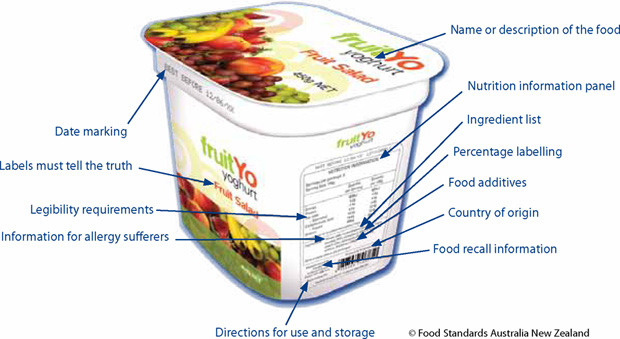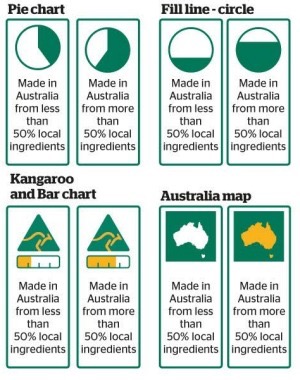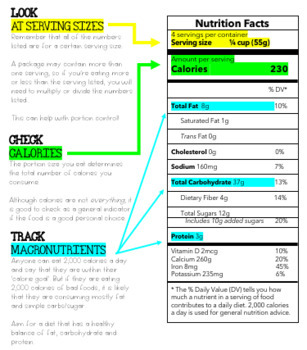39 how to read australian food labels
How to read a food label - Healthy Kids How to read a food label. Choosing foods in the supermarket can be difficult, so here's a handy guide to help you make decisions. Food labels - Better Health Channel The food label will tell you all sorts of information, including: what the food is manufacturer's details nutrition information ingredients weights and measures of product date marking directions for use and storage country of origin allergens and additives any nutrition and health claims.
PDF Reading food labels - Queensland Health Reading food labels . Understanding how to read food labels can help you make healthy food choices. Food Standards Australia and New Zealand (FSANZ) regulates food labelling in Australia. Most packaged food and drink must have a nutrition information panel. Exceptions include those in very small packages, some baked products and take-away food. 100g.

How to read australian food labels
Labelling poster - how to read food labels To help identify a food, food labels must show: the name of the food. the name and business address in Australia or New Zealand of the supplier of the food. the lot identification of the food. The name or description of the food must reflect its true nature (e.g. strawberry yoghurt must contain strawberries). PDF how to understand food labels - Eat For Health Generally choose foods with less than 10g per 100g. For milk, yogurt and icecream, choose less than 2g per 100g. For cheese, choose less than 15g per 100g. Saturated Fat Aim for the lowest, per 100g. Less than 3g per 100g is best. Sodium (Salt) Choose lower sodium options among similar foods. Food with less than 400mg per Food labels: a guide to reading nutrition labels - MyDr.com.au Solid foods labelled as 'low-fat' must not contain more than 3 grams of fat per 100 gram; 'low-fat' liquid foods must not contain more than 1.5 grams of fat per 100 mL. Only foods that are low fat can use a fat-free claim. Labels can therefore only claim that a food is 97%, 98% or 99% fat free. 'Low cholesterol'.
How to read australian food labels. Understanding food labels: How to read Australian nutritional panels Under FSANZ rules, these labels must reveal how much of the following is in the product: Energy (in kilojoules or both kilojoules and calories) Protein Fat Saturated fat Carbohydrates Sugars Sodium (salt) These contents must show average amount per 100g (or 100ml for liquids) and per serving. A breakdown of what's on nutrition labels How to understand food labels - Eat For Health The Nutrition Information Panel on a food label offers the simplest and easiest way to choose foods with less saturated fat, salt (sodium), added sugars and kilojoules, and more fibre. It can also be used to decide how large one serve of a food group choice or discretionary food would be and whether it's worth the kilojoules. How to read food labels in Australia: Find nasties and real nutritional ... My advice for reading food labels is to look at the 'per 100g' values, as 'per serve' can often be misleading if you're likely to eat more than the suggested serving size. The 'per 100g' column is also the most useful for comparing products to assess their sugar, protein, sodium and fat content. Understanding food labels fact sheet - NDSS Food labels will typically include a nutrition information panel, list of ingredients, the 'use by' or 'best before' date and identify potential food allergens and additives. Food labels also tell you the amount of carbohydrates (carbs) you eat and drink. This can help you manage your blood glucose levels.
Food label reading guide | Nutrition Australia Reading food and drink labels can help us make healthy choices. Food and drink labels will include information about the product, where and when it was made and a statement of ingredients, as well as any warnings or allergen statements. Most food or drink packages have a Nutrition Information Panel (NIP) which tells you the quantity of various nutrients a product contains per serve and per 100g or 100 ml. Reading food labels | Heart Foundation Reading food labels Nutrition information panels and ingredients lists are a good way of comparing similar foods so you can choose the healthiest option.... Using simple blood and urine tests to detect early risk of heart attack How to read food labels | healthdirect The label will tell you: the name of the product, describing accurately what it is the brand name what ingredients it contains (listed in order from largest to smallest by weight) nutritional information (such as average amount of energy, fat, protein, sugars and salt) Healthy shopping: how to read food labels | Queensland Health Read the ingredients list. All packaged foods will have a list of the ingredients in the food on the back or side of the package. These ingredients are listed by weight, in order of the ingredients used most to least. It may take a bit of extra time to read the labels but once you know what to look for it will become a faster process.
Food labels: How to read and decipher the fine print - ABC News Labels must show the name of the food, the business address and the batch or lot identification of the food. The regulator is specific here. This yoghurt would have to be called "strawberry-flavoured yoghurt" if it didn't contain any real fruit. 4. Allergy and intolerance information How to read a food label - Student Wellbeing Hub How to read a food label. Find concise information for secondary school students about how to read a food label in terms of the fat, sugar and sodium content of a food or drink. How to read a label | NSW Food Authority How to read a label Nearly every food product requires a label with specific information that tells us what's in it, how to handle it, and where it has come from, to help us make healthy and safe food choices. See Labels & the law for a list of everything that should be included on a food label. Ingredients & Nutrition Reading food labels to avoid food allergies and intolerances Reading food labels to avoid food allergies and intolerances In Australia all packaged foods must include a food label. Food labelling is governed by Food Standards Australia New Zealand (FSANZ). Nutrition information is found in two places on a food label: the ingredient list and the nutrition information panel. Sample food label

Australia's food and nutrition 2012: in brief, In brief - Australian Institute of Health and Welfare
Food labelling FAQs | ACCC The Country of Origin Food Labelling Information Standard (Standard) commenced on 1 July 2016. The Standard establishes a new system for the country of origin labelling of food products sold in Australia. Businesses have up to two years to transition to the labelling requirements set out in the Standard. During the transition period, businesses ...

Australian Food and Grocery Council wants quantity information on food packaging to be allowed ...
How to read food labels | New Idea Magazine Here are some tips on how to read food and nutritional labels: Nutritional panel Considered the most valuable part of the label, this panel shows the average amount of energy - measured in kilojoules - protein, fat, saturated fat, total carbohydrates, sugars and sodium in a product.
Reading food labels - Food Allergy Education How to read food labels that meet the new PEAL law Under the new PEAL law, common food allergens are to be listed with the plain English name alongside the actual ingredient name. This is shown in the label example below. In the statement of ingredients, declarations must: Be in bold font. Have bold font contrasting distinctly with other text.
Food labelling | Health and wellbeing | Queensland Government Food labels help consumers make informed choices about what they eat. Food labels help to protect public health and safety by displaying important information such as expiry dates, ingredients, allergens, instructions for storage and use, and warning statements. Food labelling standards are set out in the Australia New Zealand Food Standards ...
How to read a nutrition label and use it to help lose weight - Aunty Lils Place - Personalised ...
Reading food labels & nutrition panel - Diabetes Queensland higher fibre. Every food label tells a story and the Nutrition Information Panel simply gives you the facts. Ingredients list records all food ingredients and additives in order from greatest to smallest amount by weight. Importantly, the ingredient list must declare if the product contains common allergens such as milk, eggs, nuts and gluten.
What's on a food label | NSW Food Authority How to read a label What's on a food label What's on a food label Food name The name of a food must be sufficient to indicate its true nature. For example, 'fruit yoghurt' should contain fruit. If it is fruit flavouring, the product should say 'fruit flavoured yoghurt'. For more visit FSANZ.
How to decode food labels - No Money No Time Health Star Ratings were introduced in Australia and New Zealand in 2014 as a way of rating the nutritional value of packaged foods and being able to compare similar products. The rating ranges from 0.5 stars (least healthy) to 5 stars (most healthy). The number of stars is calculated based on the total energy, saturated fat, sodium, sugar ...
PDF Food label reading guide - Nutrition Australia • The more stars out of five, the healthier the food or drink choice. Food labels Reading food and drink labels can help us make healthy choices. Food and drink labels will include information about the product, where and when it was made and a statement of ingredients, as well as any warnings or allergen statements. Most food or drink packages
The inside story: How to read the label on your food In a 5g teaspoon of salt there are roughly 2g of sodium and 3g of chloride. (To get a rough idea of how much salt is in your food read the number of milligrams of sodium per serve. Multiply by 2.5 then divide by 1000.) The World Health Organisation recommends that we eat no more than a teaspoon or 5g of salt a day.
Labelling - Food Standards FSANZ sets food labelling standards in the Food Standards Code. These standards are enforced by the Australian states and territories and, in New Zealand, by the Ministry for Primary Industries (MPI). The Food Standards Code includes the general labelling and information requirements (Chapter 1 of the Code) that are relevant to all foods, and sets ...
How to read food labels | Food safety at home | NZ Government The date marks are: Use By - don't eat the food after the date. It's illegal to sell food past a Use By date. Best Before - may still be safe to eat after the date but the food may have lost some quality. Food can be sold beyond a Best Before date as long as it's still fit for human consumption.
Food labels: a guide to reading nutrition labels - MyDr.com.au Solid foods labelled as 'low-fat' must not contain more than 3 grams of fat per 100 gram; 'low-fat' liquid foods must not contain more than 1.5 grams of fat per 100 mL. Only foods that are low fat can use a fat-free claim. Labels can therefore only claim that a food is 97%, 98% or 99% fat free. 'Low cholesterol'.
PDF how to understand food labels - Eat For Health Generally choose foods with less than 10g per 100g. For milk, yogurt and icecream, choose less than 2g per 100g. For cheese, choose less than 15g per 100g. Saturated Fat Aim for the lowest, per 100g. Less than 3g per 100g is best. Sodium (Salt) Choose lower sodium options among similar foods. Food with less than 400mg per

34 sickened: Proposed new Australian food labelling laws released following Hepatitis A outbreak ...
Labelling poster - how to read food labels To help identify a food, food labels must show: the name of the food. the name and business address in Australia or New Zealand of the supplier of the food. the lot identification of the food. The name or description of the food must reflect its true nature (e.g. strawberry yoghurt must contain strawberries).









Post a Comment for "39 how to read australian food labels"